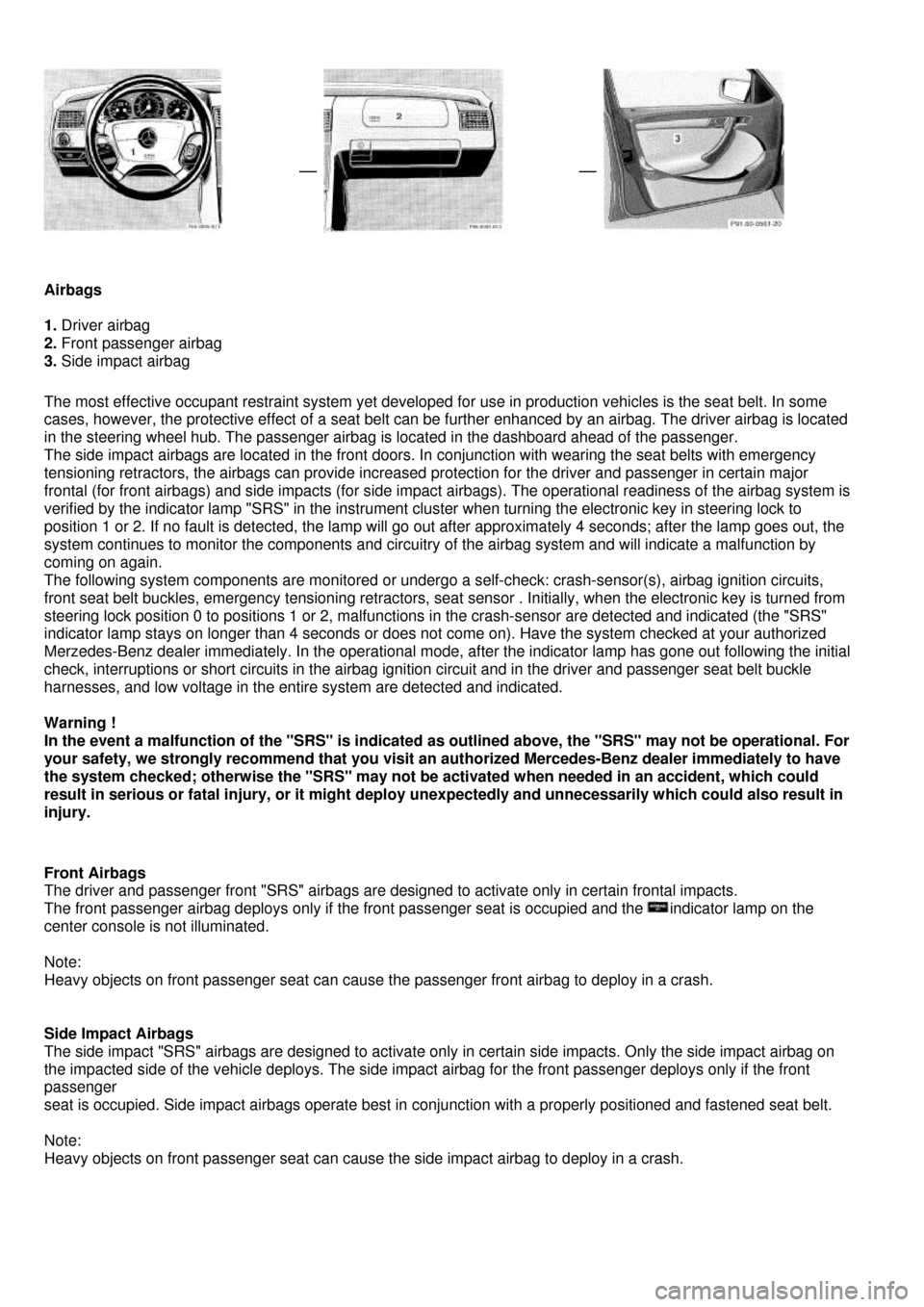steering MERCEDES-BENZ C-Class 2000 W202 Owner's Guide
[x] Cancel search | Manufacturer: MERCEDES-BENZ, Model Year: 2000, Model line: C-Class, Model: MERCEDES-BENZ C-Class 2000 W202Pages: 130, PDF Size: 2.43 MB
Page 37 of 130

Seat Belts and Supplemental Restraint System (SRS)
Your vehicle is equipped with seat belts for all se ats, emergency tensioning retractors for the front
seats, as well as front and side impact airbag s and knee bolsters for driver and front passenger.
Seat Belts
Important !
Laws in most states and all Canadian provinces require seat belt use. All states and provinces
require use of child restraints that comply with U.S. Federal Motor Vehicle Safety Standard 213 and
Canadian Motor Vehicle Safety Standard 213
All child restraint systems are designed to be secure d in vehicle seats by lap belts or the lap belt
portion of a lap-shoulder belt.
For your safety and that of your pass engers we strongly recommend their use.
Warning !
Children 12 years old and under must never ride in the front seat, except in a Mercedes-Benz
authorized BabySmart™ compatible child seat, which operates with the BabySmart™ system
installed in the vehicle to deactivate the passenger side front airbag when it is properly
installed. Otherwise they will be struck by the airbag when it inflates in a crash. If this
happens, serious or fatal injury will result. The back seat is the safest place for children.
Infants and small children must ride in back seats and be seated in an appropriate infant or
child restraint system, which is properly secured with the vehicle's seat belt, fully in
accordance with the seat manufacturer's instructions. A child's risk of serious or fatal
injuries is significantly increased if the child restraints are not properly secured in the vehicle
and the child is not properly secured in the child restraint.
Warning !
Never ride in a moving vehicle with the seat back reclined. Sitting in an excessively reclined
position can be dangerous. You could slide under the seat belt in a collision. If you slide
under it, the belt would apply force at the abdomen or neck. That could cause serious or even
fatal injuries. The seat back and seat belts provide the best restraint when the wearer is in an
upright position and belts are properly positioned on the body.
Seat Belt Warning System
With the electronic key in steering lock position 2, a warning sounds for a short time if the driver's
seat belt is not fastened.
Warning !
Failure to wear and properly fasten and position your seat belt greatly increases your risk of
injuries and their likely severity in an accident. You and your passengers should always wear
seat belts.
If you are ever in an accident, your injuries can be considerably more severe without your
seat belt properly buckled. Without your seat belt buckled, you are much more likely
to hit the interior of the vehicle or be ejected from it. You can be seriously injured or killed.
In the same crash, the possibility for injury or death is lessened with your seat belt
buckled.
Page 40 of 130

BabySmart™ Airbag Deactivation System
Special child seats, designed for use with the Mercedes-Benz system and available at any
authorized Mercedes-Benz dealer are required for use with the BabySmart™ airbag deactivation
system. With the special child seat properly installed, the passenger front airbag will not deploy. The
indicator lamp located on the center console will be illuminated, except with electronic key
removed or in steering lock position 0. The system does not deactivate the door mounted side
impact airbag.
BabySmart is a trademark of Siemens Automotive Corp.
Warning !
The BabySmart™ Airbag Deactivation System will ONLY work with a special seat designed to
operate with it. It will not work with seats which are not BabySmart™ compatible. Never place
anything between seat cushion and child seat (e.g. pillow), since it reduces the effectiveness
of the deactivation system. Follow the manufacturer's instructions for installation of special
child seats. The passenger side front airbag will not deploy only if the indicator lamp
remains illuminated. Please be sure to check the indicator every time you use the special
system child seat. Should the light go out while the restraint is installed, please check
installation. If the light remains out, do not use the BabySmart™ restraint to transport
children, on the front passenger seat until the system has been repaired.
Self-Test BabySmart™ Without Special Child Seat Installed
After turning electronic key in steering lock to position 1 or 2, the indicator lamp located on
center console comes on for approx. 6 seconds.
If the lamp should not come on or is continuously lit, the system is not functioning. You must see an
authorized Mercedes-Benz dealer before using any child seat on the front passenger seat.
Page 42 of 130

Emergency Tensioning Retractor (ETR)
The seat belts for the front seats are equipped with emergency tensioning retractors.
These tensioning retractors are located in each belt's inertia reel and become operationally ready
with the electronic key in steering lock position 1 or 2. The emergency tensioning retractors are
designed to activate only when the seat belts are fastened during frontal impacts exceeding the first
threshold of the SRS and in rear impacts exceeding a preset security level. They remove slack from
the belts in such a way that the seat belts fit more snugly against the body restricting its forward
movement as much as possible. In cases of other frontal impacts, angled impacts, roll-overs, certain
side impacts, or other accidents without sufficient frontal or rear impact forces, the emergency
tensioning retractors will not be ac tivated. The driver and passengers will then be protected by the
fastened seat belts and inertia reel in the usual manner. For seat belt and emergency tensioning
retractor safety guidelines see Safety Guidelines in Index.
Page 43 of 130

Airbags
1. Driver airbag
2. Front passenger airbag
3. Side impact airbag
The most effective occupant restraint system yet developed for use in production vehicles is the seat belt. In some
cases, however, the protective effect of a seat belt can be further enhanced by an airbag. The driver airbag is located
in the steering wheel hub. The passenger airbag is located in the dashboard ahead of the passenger.
The side impact airbags are located in the front doors. In conjunction with wearing the seat belts with emergency
tensioning retractors, the airbags can provide increased protection for the driver and passenger in certain major
frontal (for front airbags) and side impacts (for side impact airbags). The operational readiness of the airbag system is
verified by the indicator lamp "SRS" in the instrument cluster when turning the electronic key in steering lock to
position 1 or 2. If no fault is detected, the lamp will go out after approximately 4 seconds; after the lamp goes out, the
system continues to monitor the components and circuitry of the airbag system and will indicate a malfunction by
coming on again.
The following system components are monitored or undergo a self-check: crash-sensor(s), airbag ignition circuits,
front seat belt buckles, emergency tensioning retractors, seat sensor . Initially, when the electronic key is turned from
steering lock position 0 to positions 1 or 2, malfunctions in the crash-sensor are detected and indicated (the "SRS"
indicator lamp stays on longer than 4 seconds or does not come on). Have the system checked at your authorized
Merzedes-Benz dealer immediately. In the operational mode, after the indicator lamp has gone out following the initial
check, interruptions or short circuits in the airbag ignition circuit and in the driver and passenger seat belt buckle
harnesses, and low voltage in the entire system are detected and indicated.
Warning !
In the event a malfunction of the "SRS" is indicated as outlined above, the "SRS" may not be operational. For
your safety, we strongly recommend that you visit an authorized Mercedes-Benz dealer immediately to have
the system checked; otherwise the "SRS" may not be activated when needed in an accident, which could
result in serious or fatal injury, or it might deploy unexpectedly and unnecessarily which could also result in
injury.
Front Airbags
The driver and passenger front "SRS" airbags are designed to activate only in certain frontal impacts.
The front passenger airbag deploys only if the front passenger seat is occupied and the indicator lamp on the
center console is not illuminated.
Note:
Heavy objects on front passenger seat can cause the passenger front airbag to deploy in a crash.
Side Impact Airbags
The side impact "SRS" airbags are designed to activate only in certain side impacts. Only the side impact airbag on
the impacted side of the vehicle deploys. The side impact airbag for the front passenger deploys only if the front
passenger
seat is occupied. Side impact airbags operate best in conjunction with a properly positioned and fastened seat belt.
Note:
Heavy objects on front passenger seat can cause the side impact airbag to deploy in a crash.
Page 44 of 130

Important !
The "SRS" airbags are designed to activate only in certain frontal (front airbags) impacts, or side (side
airbags) impacts. Only during these types of impacts, if of sufficient severity to meet the deployment
thresholds, will they provide their supplemental protection. The driver and passenger should always wear the
seat belts, otherwise it is not possible for the airbags to provide their intended supplemental protection. In
cases of other frontal impacts, angled impacts, roll-overs, other side impacts, rear collisions, or other
accidents without sufficient forces, the airbag will not be activated. The driver and passengers will then be
protected by the fastened seat belts. We caution you not to rely on the presence of an airbag in order to
avoid wearing your seat belt. The "SRS" is designed to re duce the potential of injury in certain frontal (front
airbags) impacts, and side (side impact airbags) impacts which may cause significant injuries, however, no
system available today can totally eliminate injuries and fatalities.
The activation of the "SRS" temporarily releases a small amount of dust from the airbags. This dust,
however, is neither injurious to your health, nor does it indicate a fire in the vehicle. The service life of the
airbags extends to the date indicated on the label located on the driverside door latch post. To provide
continued reliability after that date, they should be inspected by an authorized Mer cedes-Benz dealer at that
time and replaced when necessary.
Your vehicle was originally equippend with a Suppleme ntal Restraint system (SRS). The SRS airbags are
designet to activate in centrain impacts exceeding a preset treshold to reduce the potential and severity of
injury.merzedes-Benz encourages you to replace deploy ed airbags and repair any malfunktioning airbags to
ensure the vehicle will continue to provid e maximum crash protections for occupants.
Warning!
It is very important for your safety to always be in a properly seated position and to wear your seat belt.
For maximum protection in the event of a collision always be in normal seated position with your back
against
the backrest. Fasten your seat belt and ensure that it is properly positioned on the body. Since the airbag
inflates with considerable speed and force, a proper seating and hands on steering wheel position will help
to keep you in a safe distance from the airbag:
• Sit properly belted in an upright position with your back against the seat back.
• Adjust the driver seat as far as possible rearward , still permitting proper operation of vehicle controls.
• Do not lean with your head or chest close to the steering wheel or dashboard.
• Keep hands on the outside of steering wheel rim. Placing hands and arms inside the rim can increase the
risk and potential severity of hand/arm injury when the driver front airbag inflates.
• Adjust the front passenger seat rearward as far as possible from the dashboard when the seat is occupied.
• Children 12 years old and under must never ride in
the front seat, except in a Mercedes-Benz authorized BabySmart™ compatible child seat, which operates
with the BabySmart™ system installed in the vehicle to deactivate the passenger side front airbag when it
is properly installed. Otherwise they will be struck by the airbag when it inflates in a crash.
If this happens, serious or fatal injury will result . Failure to follow these instructions can result in severe
injuries to you or other occupants.
Safety Guidelines for the Seat Belt, Emergency Tensioning Retractor and Airbag
Warning !
• Damaged belts or belts that were highly stressed in an accident must be replaced and their anchoring
points must also be checked. Use only belts installed or supplied by an authorized Mercedes-Benz dealer.
• Do not pass belts over sharp edges.
• Do not make any modification that could change the effectiveness of the belts.
• The "SRS" is designed to function on a one-time-only b asis. An airbag or emergency tensioning retractor
(ETR) that was activated must be replaced.
• No modifications of any kind may be made to any components or wiring of the "SRS". This includes
the installation of additional trim material, ba dges etc. over the steering wheel hub, front passenger
airbag cover, or front door trim panels, and in stallation of additional electrical/electronic equipment on
or near "SRS" components and wiring. Keep area between airbags and occupants free of objects
( e.g. packages purses, umbrellas, etc.).
• An airbag system component within the steering wheel gets hot
after the airbag has inflated.
• Improper work on the system, including incorrect
installation and removal, can lead to possible injury
through an uncontrolled activation of the "SRS".
• In addition, through improper work there is the risk of rendering the "SRS" inoperative. Work on the
"SRS" must therefore only be performed by an authorized Mercedes-Benz dealer
• When scrapping the airbag unit or emergency tensioning retractor, it is mandatory to follow our safety
instructions. These instructions are av ailable at your authorized Merzedes-Benz
• Depending on the considerable deployment speed and the textile structure of the airbags, there is the
possibility of light skin abrasions.
Page 50 of 130

Steering Lock
0 - The electronic key can be withdrawn in this position only. The steering is locked with the electronic key removed
from the steering lock. The electronic key an be removed only with the selector lever in position "P" and the foot off
the brake pedal. After removing the electronic key or with the electronic key in steering lock position 0, the
selector lever is locked in position "P".
1 - Steering is unlocked. (If necessary, move steering wheel slightly to allow the electronic key to be turned clockwise
to position 1.) Most electrical consumers can be operated. For detailed information see respective subjects.
2 - Driving position.
3 - Starting position.
Refer to Index for Starting and turning off the engine.
Warning !
When leaving the vehicle always remove the electronic key from the steering lock, and lock the vehicle.
Do not leave children unattended in the vehicle, or with access to an unlocked vehicle.
Unsupervised use of vehicle equipment may cause serious personal injury.
Important !
If the electronic key is left in the steering lock position 0 for an extended period of time, it can no longer be turned
in the lock. In this case, remove electronic key from steering lock and reinsert.
Notes:
A warning sounds when the driver's door is opened with the electronic key in steering lock position 1 or 0. With the
engine at idle speed, the charging rate of the alternator (output) is limited. It is therefore recommended to turn off
unnecessary electrical consumers while driving in stop-and-go traffic. This precaution helps to avoid draining of the
battery. Unnecessary strain on the battery and charging system may be minimized by turning off the following power
consumers, for example: Heated seats, rear window defroster. In addition, the automatic climate air volume control
should be set to the lowest position. The steering lock can only be unlocked with the vehicle battery properly
connected.
Caution !
To prevent accelerated battery discharge and a possible dead battery, always remove the electronic key from the
steering lock. Do not leave the electronic key in steering lock position 0.
Page 51 of 130

Combination Switch
1. Low beam (exterior lamp switch position )
2. High beam (exterior lamp switch position )
3. High beam flasher (high beam available independent of exterior lamp switch position)
4. Turn signals, right
5. Turn signals, left
To signal minor directional changes, such as changing lanes on a highway, move combination switch to the point
of resistance only and hold it there. To operate the turn signals continuously, move the combination switch past the
point of resistance (up or down). The switch is automatically cancelled when the steering wheel is turned to a large
enough degree.
6 Control for windshield wiper/washer system:
Push briefly for a single wipe without adding washer fluid (use only when windshield is wet)
Push past detent point:
• windshield washer system
• optional headlamp cleaning system (only in exterior lamp positions or ).
When the washer system is activated, the wipers also operate for a limited time.
7 Windshield wiper
0 Wiper off
I Intermittent wiping (optional rain sensor:
One initial wipe, pauses between wipes are automatically controlled by a rain sensor
monitoring the wetness of the windshield.)
II Normal wiper speed
III Fast wiper speed
Note:
The windshield washer reservoir, hoses and nozzles are automatically heated.
Page 52 of 130

Windshield Washer Fluid Mixing Ratio
For temperatures above freezing: MB Windshield Washer Concentrate "S" and water 1 part "S" to
100 parts water (40 ml "S" to 1 gallon water). For temperature below freezing: MB Windshield
Washer Concentrate "S" and commercially available premixed windshield washer solvent/antifreeze
1 part "S" to 100 parts solvent (40 ml "S" to 1 gallon solvent).
Windshield Wiper Smears
If the windshield wiper smears the windshield, even dur ing rain, activate the washer system as often
as necessary. The fluid in the washer reservoir should be mixed in the correct ratio.
Blocked Windshield Wiper
If the windshield wiper becomes blocked (for example, due to snow), switch off the wiper. For safety
reasons before removing ice or snow, remove electronic key from steering lock. Remove blockage.
Activate combination switch again (electronic key in steering lock position 1).
Turn Signal Failure
If one of the turn signals fails, the turn signal indicator system flashes and sounds at a faster than
normal rate.
Page 53 of 130

Exterior Lamp Switch
Off
Parking lamps (also side marker lamps, taillamps, license plate lamps, instrument panel lamps)
Canada only: When the engine is running, the low beam is additionally switched on.
Parking lamps plus low beam or high beam headlamps (combination switch pushed forward).
Standing lamps, right (turn left one stop).
Standing lamps, left (turn left two stops).
Front fog lamps (pull out one stop) with parking lamps and/or low beam headlamps on.
Rear fog lamp (pull out to 2nd detent) in addition to fog lamps. Yellow indicator lamp in lamp switch
comes on.
Standing Lamps
When the vehicle is parked on the street the standing lamps (right or left side parking lamps) can be turned on,
making the vehicle more visible to passing vehicles The standing lamps cannot be operated with the electronic key in
steering lock position 2.
Note:
With the electronic key removed and a front door open, a warning sounds if the vehicle's exterior lamps (except
standing lamps) are not switched off. Fog lamps will operate with the parking lamps and the low or high
beam headlamps Fog lamps should only be used in conjunction with low beam headlamps
Consult your State or Province Motor Vehicle Regulations regarding allowable lamp operation. Fog lamps are
automatically switched off when the exterior lamp switch is turned to position .
Daytime Running Lamps
Canada only
When the engine is running and the selector lever is in a driving position, the low beam (includes parking lamps,
side marker lamps, taillamps and license plate lamps) are automatically switched on.
When shifting from a driving position to position "N" or "P", the low beam switches off (2 seconds delay).
For nighttime driving the exterior lamp switch should be turned to position to permit activation of the high beam
headlamps.
Page 54 of 130

Night Security Illumination
When exiting the vehicle after driving with the exterior lamps on, they switch on again for added illumination for
approximately 30 seconds after closing the last door. The lamp-on time period can be changed at your
Mercedes-Benz dealer.
Inside Rear View Mirror
Manually adjust the mirror.
Use your inside mirror to determine the size and distan ce of objects seen in the passenger side convex mirror.
Antiglare Night Position
With the electronic key in steering lock position 2, the mirror reflection brightness responds to changes in light
sensitivity. With gear selector lever in position "R", or with the interior lamp switched on, the mirror brightness
does not respond to changes in light sensitivity.
Note:
The automatic antiglare function is restricted, if incoming light is not aimed directly at sensors in the mirror.